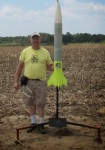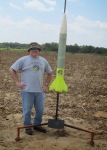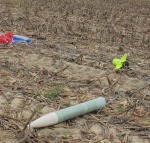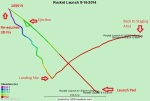Rocket Smartphone APRS Payload
Greg, N4KGL and I worked on a joint project to build and launch an APRS rocket payload. We finally got to launch it yesterday after a small delay due to field availability. It included the Mobilinkd bluetooth adapter, Baofeng Uv-5r HT and a eBay special android smartphone (appropriately from “Boost”).
Our goals were to:
- Have a successful launch and recover (of course!)
- Use APRS for tracking using stock Ham radio equipment and smartphone
- Use the on-board smartphone sensors to record audio and accelerometer data
- Map ground track using My Tracks for further analysis
Ground Station:
- Laptop with a RTL-SDR dongle and USB GPS
- SDR# tuned to the APRS frequency 144.390
- APRSIS32, VNCViewer, UZ7HO SoundModem Software TNC
- VB-Cable Virtual Audio capture
- Linksys Router with DD-WRT and Homebrew antenna
Note: You can view the Google Doc prepared for this flight with more detail.
The ground station was connected via 802.11g while the rocket was sitting on the launcher. I was able to control the phone screen through VNC and start the audio recording, Sensor logger, APRS and My tracks while it was sitting on the pad waiting for launch. That capability was instrumental in starting and checking all the services prior to launch.
Field conditions were excellent, although it was a little windy at times and very hot. Greg prepared the rocket while I prepared the ground station and prepped the payload. Greg decided to try out a new rocket motor that he had never used before. It was a disposable J425R-14A high powered rocket motor. It performed flawlessly from start to finish and sounded awesome!
I was quite surprised in how the phone GPS performed. It lost GPS fix during the accent phase but quickly reacquired lock after chute deployment. I chose My Tracks to do the GPS logging because of the logging rate and it integrates well with other GPS software. I am sure there is something better/faster but this seemed to work well for this launch.
Data Sets:
- Audio File from inside the rocket
- Comma Delimited File of Accelerometer Data
- Google Earth File from “My Tracks”
- GPX file of flight
Please visit Greg’s post for more pictures and info.
Video of Launch: The second half of the video is of smartphone audio synchronized with video, very cool!
- Mobilinkd
- UV-5R and Smartphone
- Payload
- Payload inserted
- Payload inserted
- Greg, N4KGL
- Jason, N4JTC
- Greg preparing ignitor
- Ground Station
- Rocket Motor Used
- Launch!
- Landing
- APRS.fi Page
- Acceleromter Data
- Elevation Profile GPS Data
Posted on August 17, 2014, in Digital, Experimentation, Portable Field Ops, SDR, Software. Bookmark the permalink. Leave a comment.
















Leave a comment
Comments 0